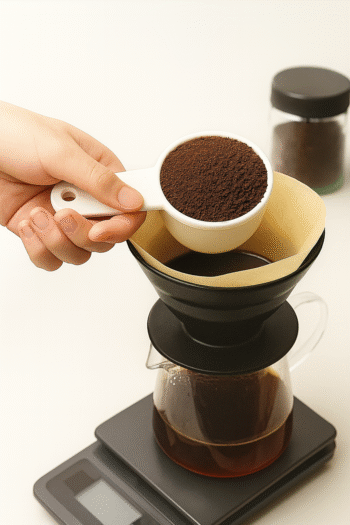Dubai – Qahwa World
Making coffee is not just a matter of taste — it’s a craft built on precision, balance, and understanding. Among the most essential principles guiding professional baristas and home brewers alike is the Golden Ratio, a simple yet powerful formula that ensures every cup achieves the right harmony between strength, flavor, and smoothness.
What Is the Golden Ratio?
According to the Speciality Coffee Association (SCA), the ideal coffee-to-water ratio lies between 1:15 and 1:20, meaning 1 gram of ground coffee for every 15 to 20 grams of water. This proportion defines how rich, strong, or light your brew will be.
A lower ratio (such as 1:15) produces a bolder, more intense cup, while a higher ratio (like 1:18) results in a gentler flavor — ideal for black coffee drinkers. These figures form the universal foundation of balanced brewing used across drip machines, pour-over setups, and French presses.
Weight Over Volume
The Golden Ratio is based on weight, not volume. Because grind size affects density, measuring coffee by scoops or spoons leads to inconsistency. For precision, use a digital scale to weigh both coffee and water accurately.
Key Factors That Shape Coffee Quality
Even when you follow the Golden Ratio, several factors influence how your coffee tastes.
1. Grind Size
Grind size determines how quickly and thoroughly water extracts flavor from the grounds.
French press: Coarse grind, similar to sea salt.
Pour-over: Medium to slightly fine grind.
Drip coffee maker: Consistent medium grind.
An improper grind can cause under-extraction (sour taste) or over-extraction (bitterness).
2. Water Temperature
The SCA recommends a brewing temperature between 195°F and 205°F (90°C to 96°C). Boiling water can burn coffee grounds and create a harsh taste, while cooler water prevents proper extraction.
3. Agitation and Flow
The way water moves through coffee — whether by pouring, stirring, or immersion — affects extraction balance. Gentle agitation helps saturate all particles evenly, producing a more consistent cup, especially in pour-over or French press methods.
4. Filter Type
The filter acts as the final gate between the brewing process and your cup.
Paper filters trap oils and fine particles, resulting in a clean, light-bodied brew.
Metal filters allow oils to pass through, enhancing texture and body.
Both have merit; the choice depends on your personal preference for clarity or richness.
Best Practices for a Perfect Brew
Use a scale. Measuring by weight ensures accuracy and repeatability.
Choose fresh coffee. Recently roasted beans yield livelier, more expressive flavors.
Invest in a good grinder. A burr grinder provides a consistent grind size, leading to more even extraction.
Stay consistent. Pick a brewing method you can comfortably repeat every day.
Experiment with confidence. Once you’ve mastered the basics, adjust ratios or grind settings slightly until you find your ideal cup.
The Essence of Balance
The Golden Ratio is not a secret formula but a timeless principle — a shared standard among coffee professionals and enthusiasts worldwide. When respected alongside the right grind size, temperature, and technique, it transforms coffee brewing from routine to ritual.
With precision, balance, and consistency, anyone can create a cup worthy of the world’s finest cafés — right at home.
The post The Golden Ratio of Coffee: The Secret to Perfect Balance in Every Cup appeared first on Qahwa World.




